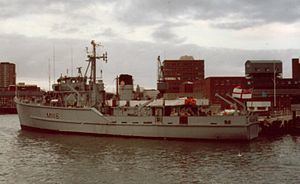Name HMS Wilton (M1116) Ordered 11 February 1970 Commissioned 14 July 1973 Construction started 7 August 1970 Length 47 m Displacement 408,200 kg Builder Woolston | Operator Royal Navy Laid down 7 August 1970 Decommissioned 1994 Launched 18 January 1972 Weight 457.2 tons Draft 2.59 m | |
 | ||
HMS Wilton (M1116) was a prototype coastal minesweeper/minehunter for the Royal Navy. She was the first warship in the world to be constructed from glass-reinforced plastic. Her design was based upon the existing Ton class minesweepers, and she was fitted with equipment recovered from the scrapped HMS Derriton. The use of GRP gave the vessel a low magnetic signature against the threat of magnetic mines.
On commissioning, Wilton joined the 2nd Mine Counter Measures Squadron based at Portsmouth. In 1974, she took part in Operation Rheostat, the Royal Navy's part of the international efforts to clear the Suez Canal of mines. In November that year, Wilton rejoined 2nd MCMS, interrupting her service with that squadron to be seconded to STANAVFORCHAN, NATO's Standing Naval Force Channel in 1977 and 1980.
Wilton was unofficially known as HMS Tupperware, HMS Indestructible, and "The Plastic Duck" or "Plastic Pig". She was retired by the Royal Navy in 1994; she ended up in store until being sold in August 2001, when she was fitted out as the new home of the Essex Yacht Club at Leigh-on-Sea on the Thames Estuary.
